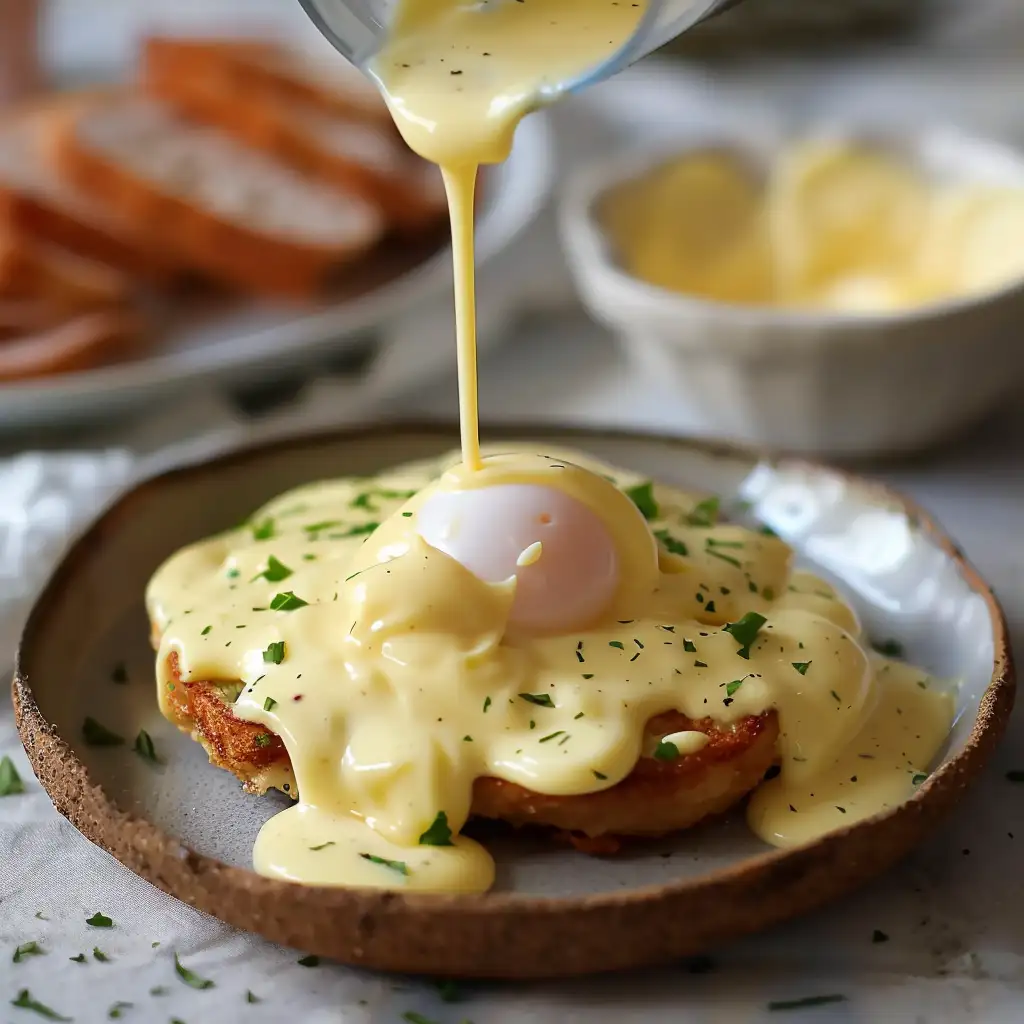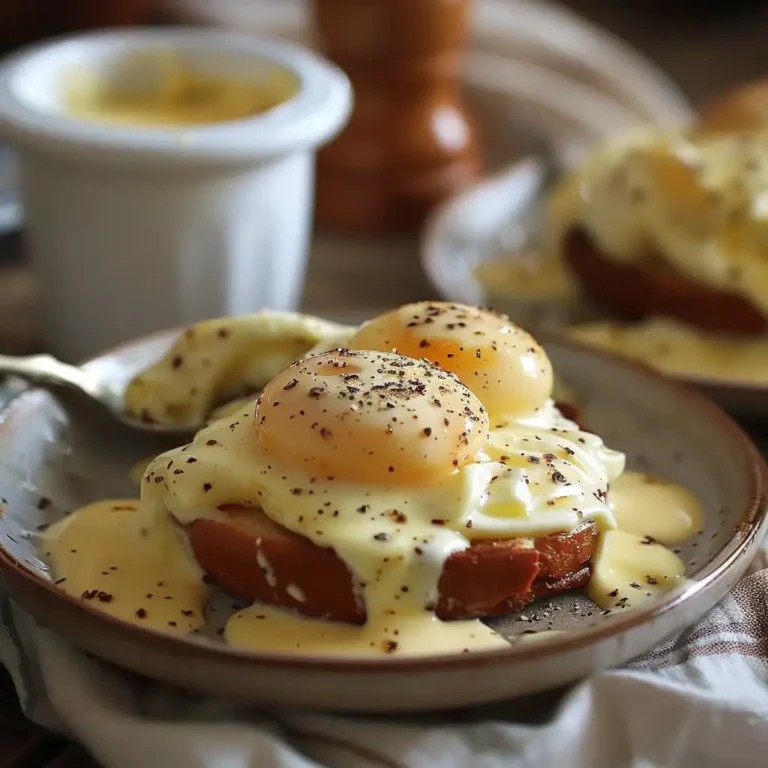Introduction to Blender Hollandaise Sauce
Blender Hollandaise sauce represents the epitome of simplicity and speed in the kitchen, transforming a traditional recipe that typically requires meticulous whisking and careful temperature control into a foolproof, quick process. Traditionally, Hollandaise is one of the five mother sauces in French cuisine, known for its rich, buttery flavor and delicate consistency. The classic method involves emulsifying melted butter into egg yolks and lemon juice over a double boiler—a technique that can be intimidating and time-consuming.
However, with the advent of modern kitchen appliances, the blender offers a remarkable shortcut. Making Hollandaise in a blender not only saves time but also reduces the risk of the sauce separating. This modern twist on a classic not only maintains the sauce’s luxurious texture but enhances its accessibility for home cooks of all levels.
Ingredients Needed
- Egg yolks – the base of the emulsion, providing richness and color
- Lemon juice – adds brightness and a tangy flavor to balance the richness
- Dijon mustard – introduces a subtle sharpness and depth
- Hot sauce – gives a slight kick that can be adjusted to taste
- Butter – unsalted is preferred for a smooth, velvety finish
Equipment Needed
- A reliable blender is crucial for this recipe, as it will do all the heavy lifting of emulsifying the ingredients into a smooth, creamy sauce.
By using these simple tools and ingredients, anyone can whip up a delicious Blender Hollandaise sauce with minimal effort. For additional tips on achieving the perfect texture and flavor, culinary enthusiasts can explore culinary techniques for sauces, which provides a wealth of information suitable for both novices and seasoned cooks.

Step-by-Step Recipe Guide
Preparation of Ingredients
To ensure a smooth cooking process, start by preparing all your ingredients:
- Separate the egg yolks from the whites.
- Measure out the lemon juice, Dijon mustard, and hot sauce.
- Cut the butter into chunks to ensure it melts evenly.
Detailed Step-by-Step Blending Process
- Place the egg yolks, lemon juice, Dijon mustard, and hot sauce into the blender. Blend on medium speed until the mixture is smooth and slightly pale.
- In a microwave-safe container, heat the butter until completely melted and hot, but not boiling. For a guide on proper butter melting techniques, refer to Food Safety Guidelines.
- With the blender running on low, slowly drizzle the hot butter into the mixture. It’s crucial to add the butter slowly to ensure it emulsifies properly with the yolks and doesn’t cook them.
Tips for Melting and Incorporating Butter
- Always use hot butter; cold butter will not emulsify properly and could break the sauce.
- Pour the butter in a thin, steady stream to avoid overwhelming the egg mixture, which can lead to separation.

Variations of Blender Hollandaise Sauce
Blender Hollandaise sauce is wonderfully versatile. Here are some tasty variations to spice up the basic recipe:
Adding Spices for a Kick
- Cayenne pepper: A pinch can add a delightful heat.
- Black pepper: Freshly ground for a more subtle warmth.
Incorporating Different Types of Mustard
- Whole grain mustard: Adds a nice texture and robust flavor.
- Honey mustard: Offers a sweet contrast to the tangy profile.
Alternative Citruses
- Lime juice: Provides a sharper, distinct twist compared to lemon.
- Orange juice: Adds a hint of sweetness and complexity.
These variations can transform the traditional Hollandaise into a customized sauce that complements a variety of dishes, from eggs Benedict to steamed vegetables. Experimenting with these ingredients can yield delightful results and bring a fresh zest to your meals. For more on using different citrus fruits in recipes, consider exploring detailed culinary resources such as culinary techniques for sauces.
Serving Suggestions
Blender Hollandaise sauce enhances a variety of dishes, from classic breakfast items to elegant dinners. Here are some perfect pairings:
- Eggs Benedict Variants: The quintessential use of Hollandaise. Try it atop traditional poached eggs with ham or Canadian bacon, or explore variations with smoked salmon or spinach for a Florentine twist.
- Vegetables: Drizzle over steamed or grilled asparagus, lightly sautéed spinach, or roasted broccoli to add a touch of luxury.
- Seafood: Elevate simple poached or grilled fish, such as salmon or cod. It’s also delicious with crab cakes or lobster.
These suggestions provide a foundational palate that can be expanded upon depending on personal tastes or dietary preferences.
Storage and Reheating Tips
To maintain the quality and safety of your Blender Hollandaise sauce, follow these storage and reheating tips:
Storage
- Store the sauce in an airtight container in the refrigerator for up to two days.
- Avoid leaving Hollandaise at room temperature for extended periods to prevent bacterial growth.
Reheating
- Reheat gently in a double boiler on the stove. Keep the heat low to avoid overheating the sauce.
- Stir constantly while reheating to maintain the emulsion and prevent separation.
If you’re uncertain about food safety, particularly when dealing with sauces containing raw eggs, consult Food Safety Guidelines for best practices.
By adhering to these tips, you can enjoy your Hollandaise sauce beyond its initial serving, ensuring every dish is as delicious as the first.
Common Mistakes and Troubleshooting
Making Blender Hollandaise can seem daunting, but understanding common pitfalls helps in achieving a perfect sauce:
Common Mistakes
- Adding butter too quickly: This can prevent proper emulsification, leading to a sauce that separates.
- Using cold ingredients: Room temperature egg yolks blend more smoothly with the hot butter.
- Overheating: Too much heat can scramble the egg yolks, ruining the sauce’s texture.
Troubleshooting Broken or Curdled Hollandaise Sauce
- If the sauce separates: Try blending a fresh egg yolk with a tablespoon of lemon juice, then slowly whisk in the broken sauce.
- If the sauce curdles: Briefly blend on low with a few ice cubes to cool and smooth the mixture.
For more detailed guidance on fixing sauces, explore resources like culinary techniques for sauces.

FAQs Section
Preventing Hollandaise Sauce from Splitting
- Use warm, not hot, butter and add it slowly while blending to maintain emulsion.
- Keep all ingredients at room temperature to help them blend more uniformly.
Making Hollandaise Sauce Ahead of Time
- Hollandaise is best made fresh but can be kept in the refrigerator and gently reheated. For tips on reheating, visit Food Safety Guidelines.
Storing Hollandaise Sauce
- Store in an airtight container for up to 48 hours. Reheat on low heat, stirring constantly to avoid overheating and splitting.
Understanding these elements will help ensure your Blender Hollandaise is consistently creamy and delicious.

